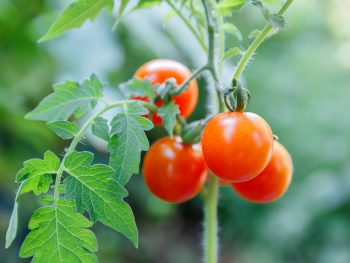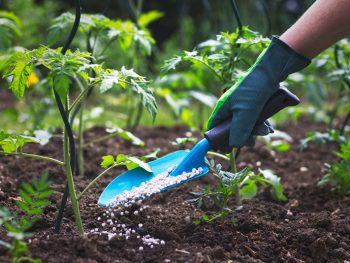
Tomatoes are staples in the kitchen and are frequently used, so most people appreciate having ripe and juicy tomatoes all the time. For some, it is a daily staple, especially if you are on a strict diet that involves all-natural food to facilitate faster metabolism.
Harvesting a good bunch of tomatoes can sometimes be a challenge, though, even for experienced gardeners like you and me. Growing these beauties to how you want them to be – that is, big, ripe, succulent, and with just the right texture – will be manageable if you follow these simple tips and tricks that I have learned through the years of trying to grow them according to my standards.
So…are you ready to find out the best way to grow tomatoes? The following tips are just among the best practices I have learned over the years in my quest to grow the best yields.
Planting

To grow in an optimal manner, tomatoes (all varieties) need to be planted in its ideal soil temperature. What is ideal, though, you might be wondering? Between 52-60 degrees Fahrenheit is where they thrive best. Exposing them to temperatures cooler than this range will stunt their growth, thereby, reducing yields.
If you live in an area where the climate is usually cooler than this temperature range, you can keep the soil temperature warm through frost protection techniques. One proven technique is using plastic mulches to cover the soil. You can also cover the plants with plastic or newspaper in cooler months to keep the ideal temperature.
Selecting the Ideal Tomato Deedlings or Transplants

Wondering what the ideal tomato seedlings look like? Knowing this simple thing will help pave the way to your dream of growing the perfect tomato fruit. The ideal seedlings have dark green leaves and are about 6-8 inches tall. Their stems are around the same as the diameter of a normal pencil.
Choosing seedlings that have white bumps along the stems are also recommended. The white bumps are roots that are beginning to form. They readily take root when planted and grown rapidly. You should plant these horizontally for maximum effect.
Spacing and Trellising
The proper trellising and spacing of the tomato seedlings will help ensure proper air circulation and will promote good drainage. Also, since their fruits are heavy, it is important that you support the plant through proper trellising to prevent stem breakage.
Spacing and trellising them properly also helps assure you of easier harvesting and lesser instances of pest infestation, especially the growth of psyllid insects. Recommended minimal spacing is around 2 feet apart.
Keep in mind that crowding plants will not help you increase yields contrary to popular belief; rather, it will increase the likelihood of diseases and similar problems. Trellises, on the other hand, should be between 4 to five feet high.
Tender seedlings tend to be sensitive to cool winds, so wrapping the cages or trellises with plastic sheets or newspapers in their first week of being transplanted is highly recommended for optimum growth.
If you choose to use just a single-pole trellis for convenience’s sake, make sure to remove all the side shoots and to do so constantly to ensure healthy growth.


Figures 3 & 4: These are the different ways you can do mulching and trellisings (source Colostate.edu)
Mulching to Ensure Proper Insulation
Insulating the soil properly – or mulching – is highly recommended with any crop. Doing so is essential when planting tomatoes. Generally, it helps manage moisture and prevent the growth of unwanted weeds that eat up the nutrients that are supposed to just be solely for your tomatoes. It also helps prevent fungal spores from the soil to contaminate the leaves.
For best results, use black plastic mulch for your tomato plot as it keeps the soil warm better than any other type and will help push production to as much as 2 to 3 weeks earlier than forecasted.
Proper Irrigation
As with all varieties of plants, proper irrigation is important for healthy growth. Some plants like lots of water, while some will die when watered too much. With tomatoes, you need to avoid sprinkling overhead on them as fungal spores will easily propagate.
You also need to avoid this because water on their leaves creates a favorable environment for the development of diseases. Just water their soil in the morning to allow them to dry during night time. This will also ensure that they grow on their ideal soil temperature.
Fertilizing Your Tomato Plants
Growing your tomatoes properly is also highly reliant on the nutrient requirements they have. They have a low requirement for nitrogen, so if you subject them to high levels of nitrogen, their vines will grow well, yes, but at the expense of bearing fruits.
During transplanting period, it is best to apply at least one to at most 3 applications of a water-soluble fertilizer, often also referred to as “plant starters.” Since transplants or seedlings usually would have hardened off of have had its growth slowed down, these water-soluble solutions will help stimulate growth once again.
Tomatoes usually grow within 6 to 8 weeks from its transplanting stage. It is recommended that you use the water-soluble fertilizers right after a cold spell for optimum effect. For best results, it is recommended that you fertilize the plants when the fruits reach around 2 inches in diameter. Do this every 2 to 4 weeks, depending on the organic content of the soil. If you are using granular fertilizers, one tablespoon per plant should do the trick. Make sure to not over-fertilize as this will kill your tomatoes.
Ripening Your Tomatoes
As I have mentioned above, you need to make sure that you keep the temperature between 52-60 degrees Fahrenheit if you want to harvest ripe, succulent tomatoes. So, what if winter is around and there is no possible way for you to grow them outdoors even with mulching their soil with black plastic and covering them up with newspapers?
Do not fret because you can also ripen them indoors. Pick the green, unripened tomatoes and wash them with water. Allow them to air dry, then store them until they ripen to their red, juicy tenderness. Doing this worked for me on a trial and error basis, so you can also make use of your best judgment depending on what your circumstances are. Just keep in mind that they tend to shrivel when the humidity is low, so keep them in a cool storage if you want good results.
Another thing you need to take note of is that ripening tomatoes produce ethylene gas, which is a hormone that induces ripening. Based on experience, when I want to speed up the ripening of my tomatoes, I place a ripe tomato in their container. If you want to slow down the ripening, you can remove ripe ones from the lot.
I do hope that I was able to help you out in your quest for the best way to grow tomatoes. Feel free to share your thoughts in the comments area. I look forward to exchanging great ideas with you.













